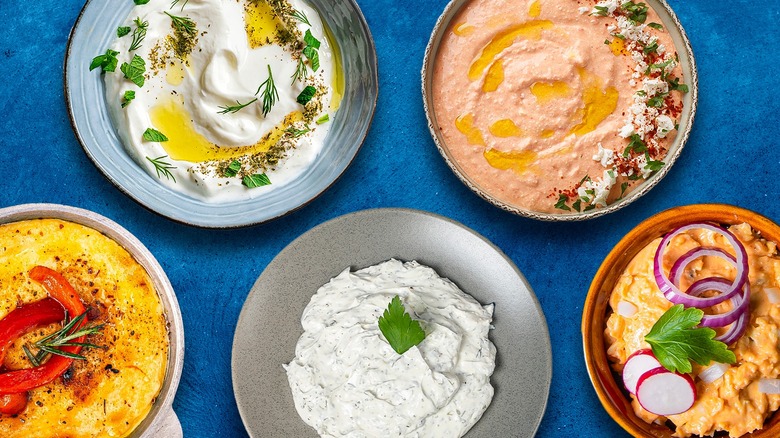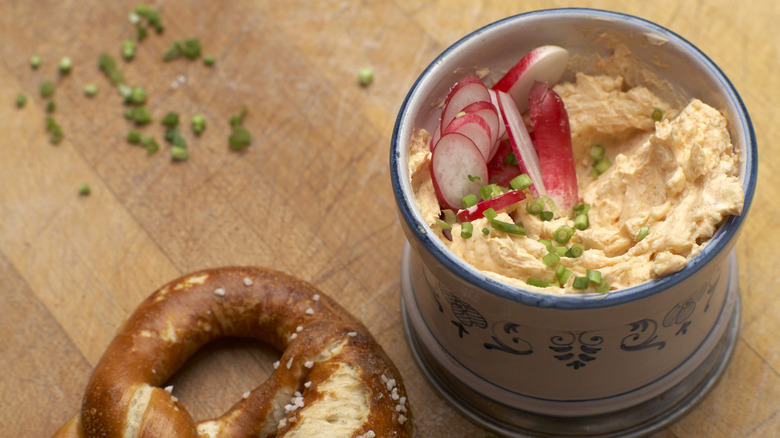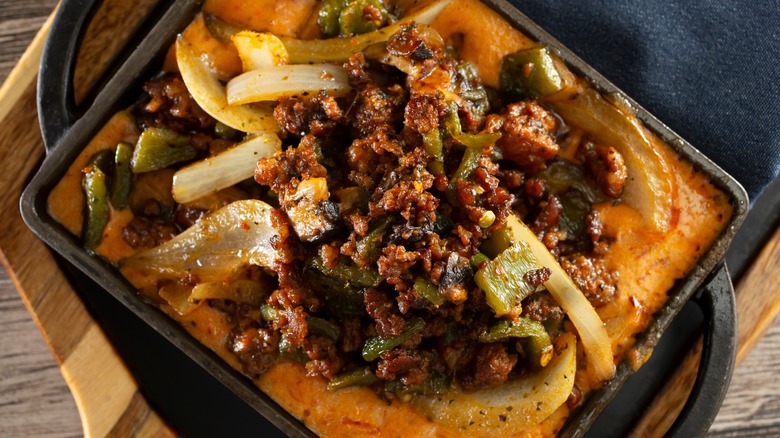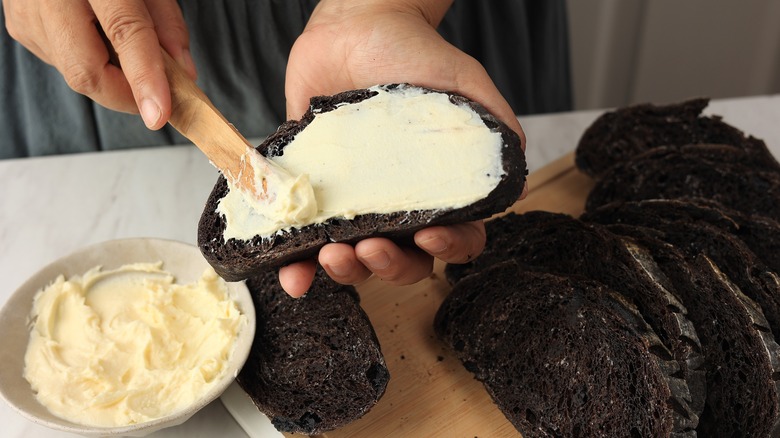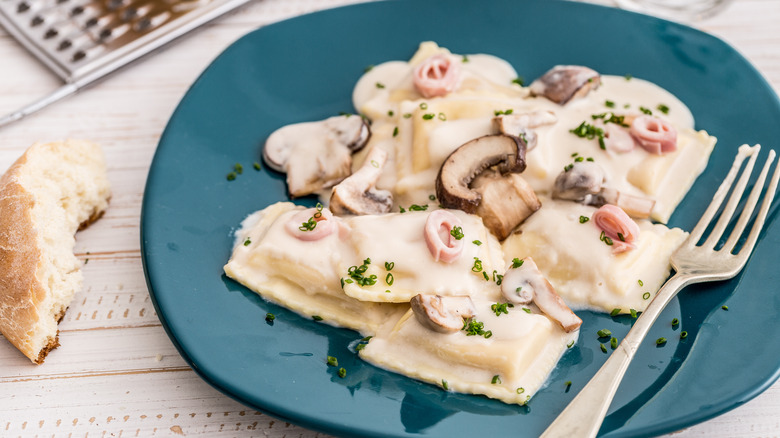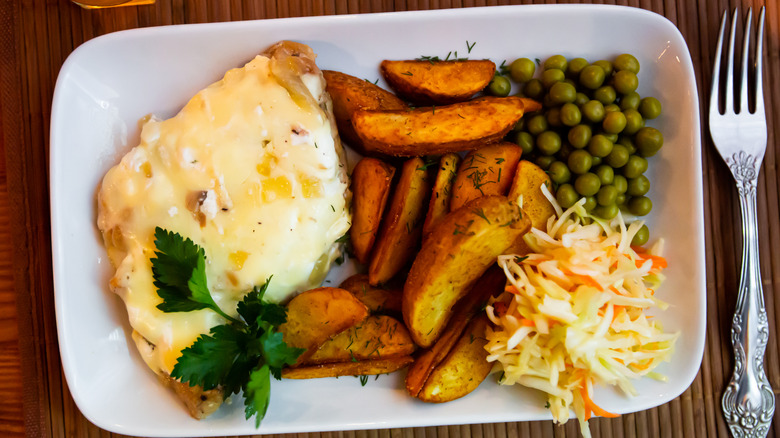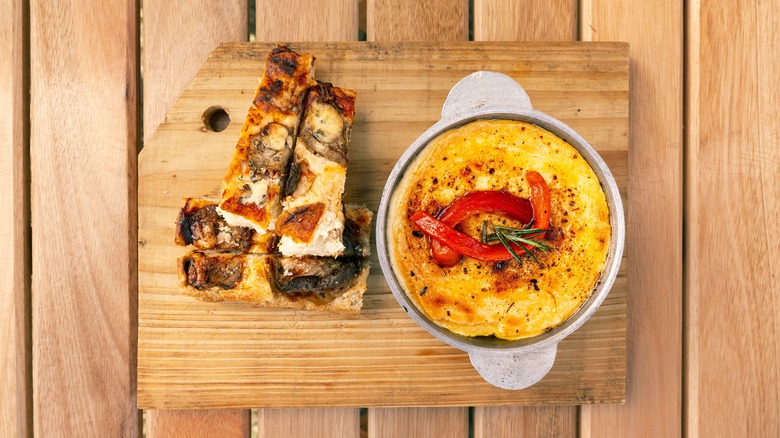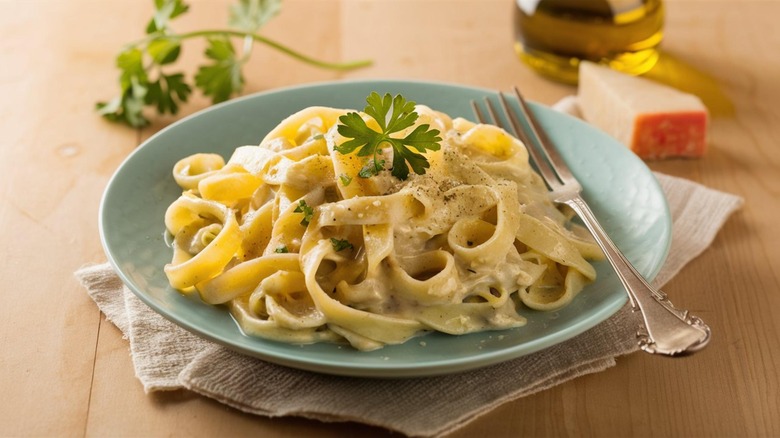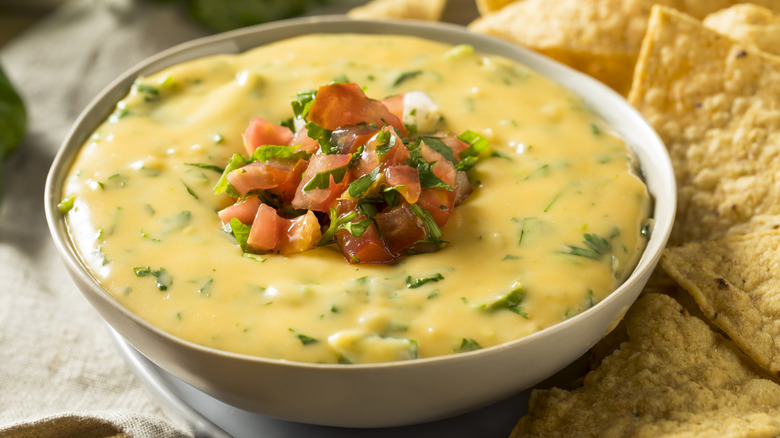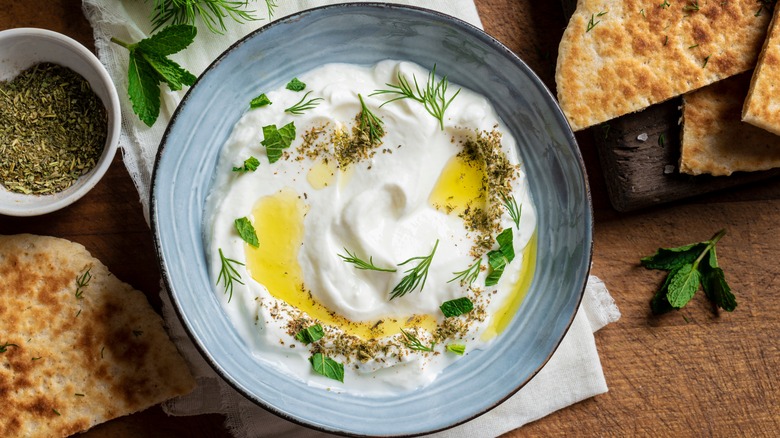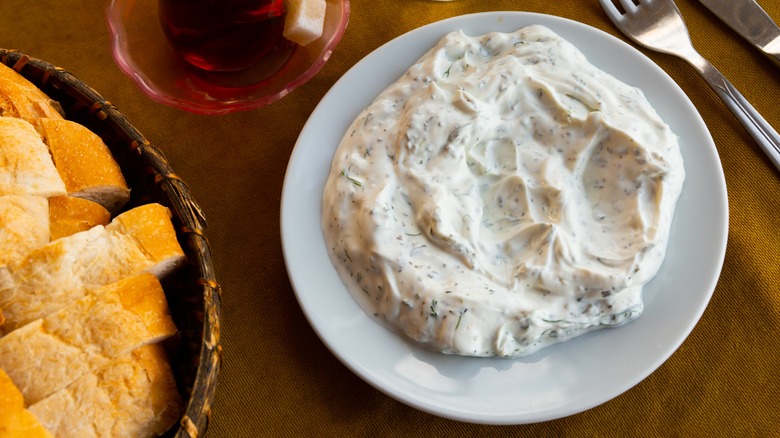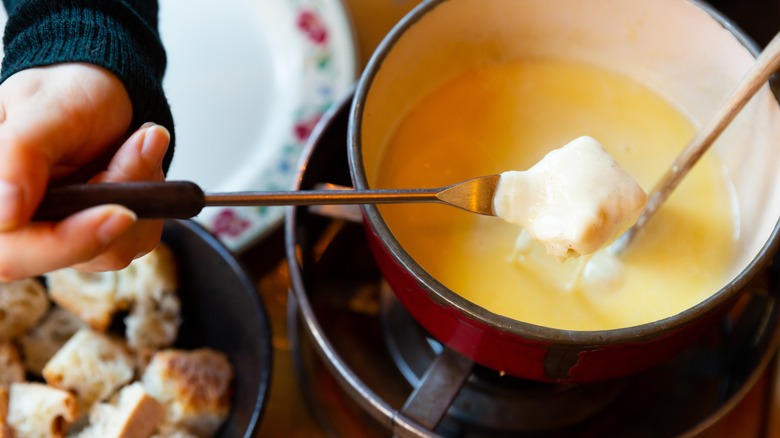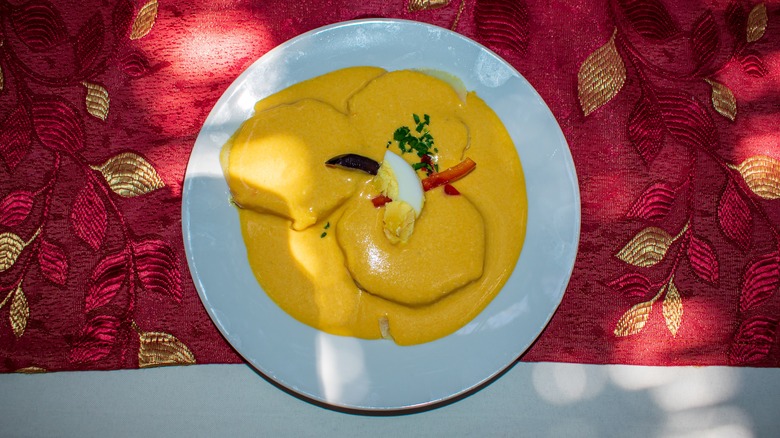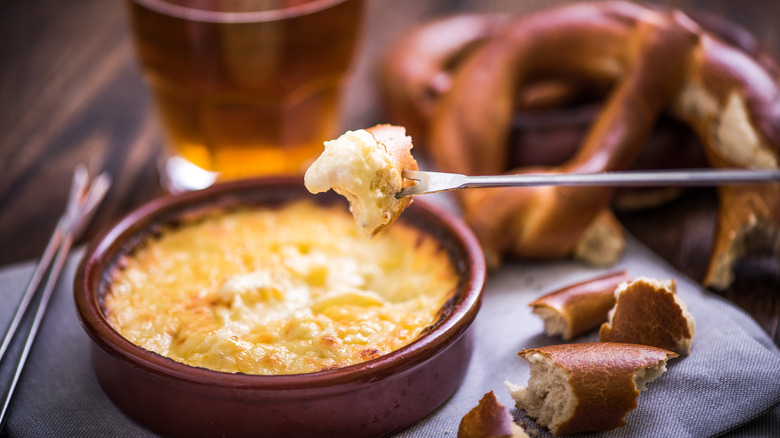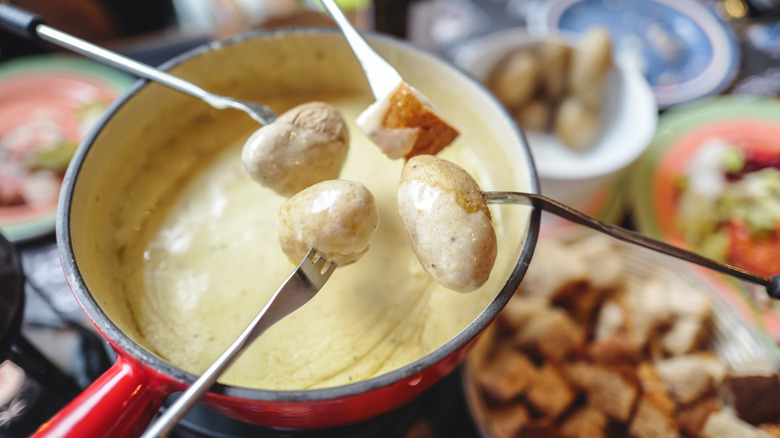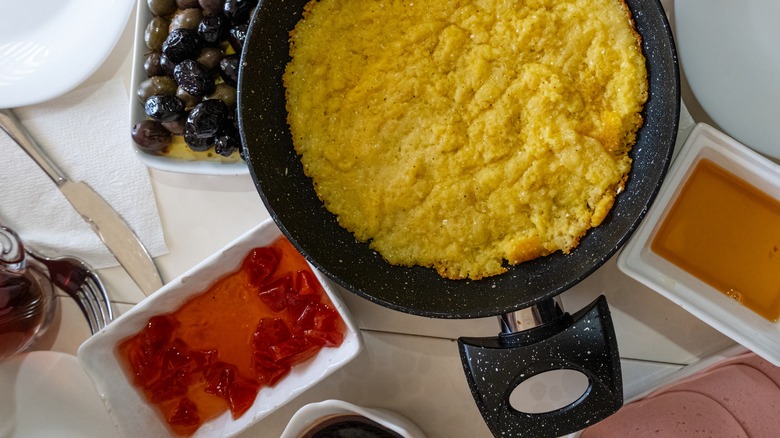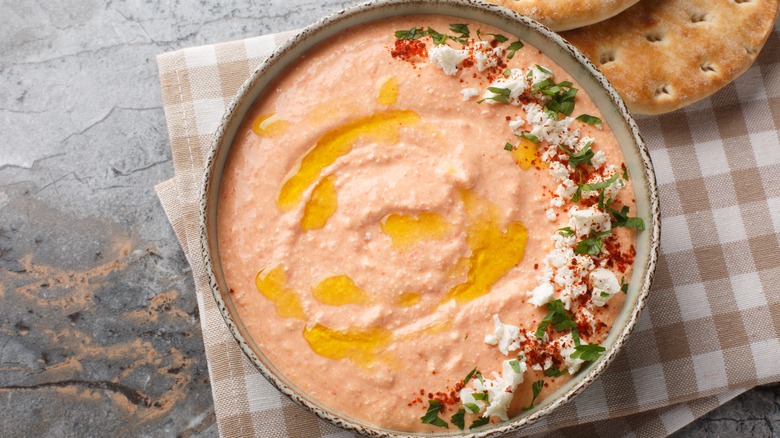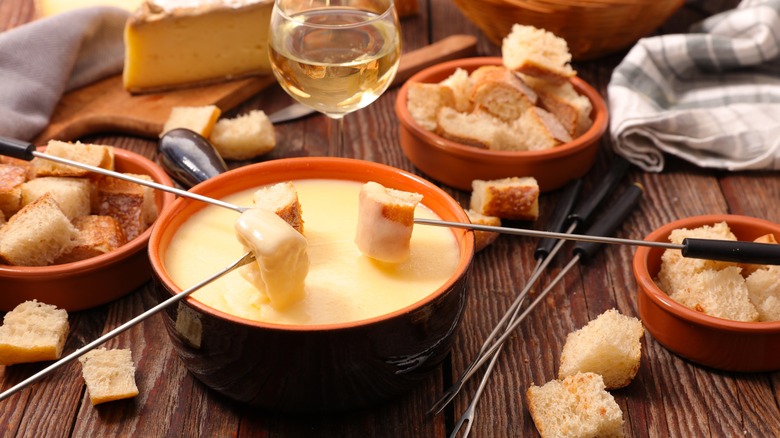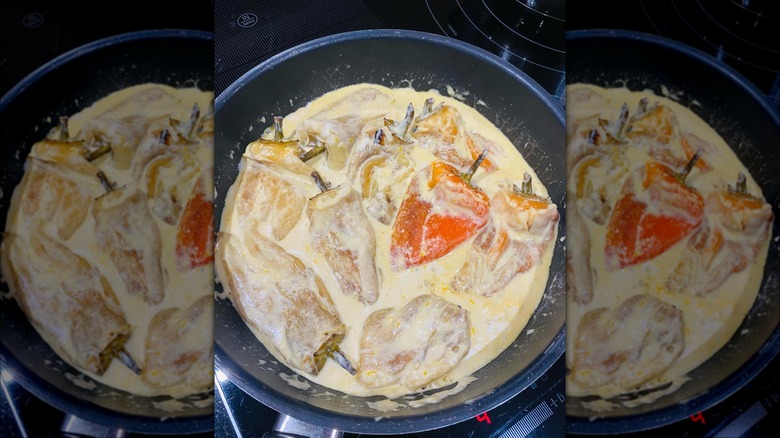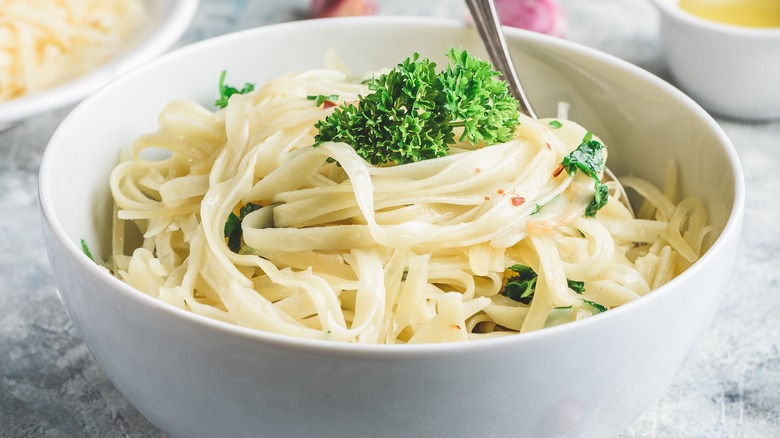20 Cheese Sauces From Around The World
If there's one food that's consistently captured the hearts of humans around the globe, we think it has to be cheese. After all, we're practically hard-wired to love cheese: Its major protein, casein, is broken down into casomorphins as we digest it, which causes our brain to release dopamine, the "feel good" hormone. This has led some to claim that cheese can be mildly addictive, but don't worry — it's not a dangerous habit.
Given the pleasure-inducing effects cheese has on the human brain, it comes as no surprise that cheese is a beloved (and even necessary) part of our diets around the world. Whether you enjoy Brie with a baguette in France or regularly enjoy a snack of chips and queso, it's a fair bet that you love at least one form of cheese. Personally, we think making dips and sauces out of cheese is an easy way to enhance a variety of cuisines, and we're not alone – various cultures around the globe have turned cheese into delectable sauces, each tailored to the tastes of its people.
Obatzda
Fans of Oktoberfest have likely run into the Bavarian beer cheese dip obatzda at least once or twice. Its invention in the late 1800s or early 1920s (sources differ) was almost a happy accident — innkeeper Katharina Eisenreich simply threw together whatever she had on hand, and her guests happened to love it. Making obatzda is as easy as stirring some ingredients together, and all you need is either Brie or Camembert cheese, spreadable cheese and butter, spices like paprika, onion, salt, and pepper, and a few tablespoons of your favorite beer.
Though the dip can be served in ramekins (as in the picture above), it's also thick enough to be formed into a ball and placed delicately on snack platters. It's commonly served alongside pretzels, bread, and even sausages. If you want to dress it up, feel free to garnish it with chives or even just a sprinkle of smoked paprika.
Queso fundido
Ah, queso — the beloved cheese dip we're willing to bet you've tried (and loved) at least once. Queso fundido, however, is a slight variation from the queso you may know and love. There are a few differences between queso and queso fundido: Whereas queso is often served as a melty cheese dipping sauce alongside chips, queso fundido is much richer, and features cheeses baked in a skillet (commonly cast iron) and often topped with sautéed vegetables or meat, like chorizo.
Rather than being used as just a dipping sauce, queso fundido is typically intended to be scooped onto warm tortillas before eating. However, there are no strict rules when it comes to a fun party dish, so feel free to eat your queso fundido however suits your fancy — by putting it on nachos, dipping tortilla chips in it, or using warm tortillas to scoop it up.
Fromage blanc spread
You were probably wondering how long it would take to see some French cuisine pop up on our list. Our next choice is a simple, smooth, saucy spread, the origin of which is thought to date back to French silk weavers in the 1800s, who would commonly eat the spread alongside their lunch. A fromage blanc spread is versatile and doesn't even have to adhere strictly to using fromage blanc as its base — you could also use spreadable goat cheese if you prefer.
Fromage blanc spread is as simple to make as it is to enjoy — all you need is fromage blanc (or your spreadable cheese of choice), a collection of savory herbs like chives, parsley, tarragon, and garlic, and some red and white wine vinegar. Enjoy it spread on a fresh baguette to transport your taste buds to your favorite French villa.
Gjetost sauce
If there's one dish on this list that we're dying to try, it has to be gjetost sauce. Gjetost is known for being surprisingly sweet and incredibly fudgy, making it a somewhat polarizing cheese that has nevertheless found a home in Scandinavian cultures; in fact, there's a good chance you can score some of the unique cheese at your local IKEA.
Again, there are no hard-and-fast rules when it comes to food, so feel free to experiment with your homemade gjetost sauce. We recommend trying it with meatballs, as is commonly done in Scandinavian countries. You can also turn gjetost into a dipping fondue with the addition of Gruyère, the Swedish cheese herrgårdsost, brandy, and white wine. Serve the fondue alongside crackers, apples, or pears.
Caruso sauce
We have Uruguay to thank for the next cheese sauce on our list, Caruso sauce. If you're thinking this dish sounds a bit Italian, you're right — though it was invented in Montevideo by chef Raymundo Monti, he drew inspiration from Italian foods. He named the dish after Italian opera singer Enrico Caruso, who visited Montevideo in the early 1900s.
Caruso sauce is a hearty blend of ham and cheese that's typically served alongside pasta. The sauce is simple to prepare and only requires cheese (mozzarella and Parmesan, to be specific), milk, butter, beef bouillon, flour, and an onion. The result is a savory cream sauce that holds up well to any shell pasta, though we recommend eating it alongside orecchiette.
Mornay sauce
The exact origin of the French Mornay cheese sauce is unknown, but popular lore says that it was named after the Duke of Mornay in the late 1500s. Regardless of exactly how it got its name, it's easy to see why Mornay sauce has had such staying power over the centuries. Today, it's commonly described as a béchamel sauce with cheese added, though it's likely that Mornay sauce was invented before the classic béchamel.
Fortunately, you can have Mornay sauce with just about anything — top a grilled chicken breast with it, incorporate it in a decadent mac and cheese, or use Mornay sauce in a delicious oyster bake. All you need to make the sauce is butter, flour, milk, Parmesan, and Gruyère. You can season it with herbs and spices to your liking, or keep it simple and classic.
Provoleta
Another cheese sauce with Italian influence, provoleta has been an Argentinian staple for over a century, ever since provolone was first introduced to the country by Italian immigrants. The unique bite of provolone made it appealing to Argentines, who started to play around with the cheese and soon found a delicious, easy way to prepare and present it.
Making provoleta is as simple as melting provolone cheese in a cast iron skillet in the oven until it gets bubbly and brown on top. We encourage you to add other ingredients you enjoy like fresh herbs, tomatoes, garlic confit, or even pesto. Use whatever vessel suits your fancy to transport the provoleta from skillet to mouth, like tortilla chips, crostini, or flatbread.
Alfredo sauce
Here's a cheese sauce we guarantee you've heard of before. In fact, there's a good bet you've had it more than once. Alfredo sauce took its name from its inventor, Alfredo di Lelio, who came up with the dish in 1908 for one simple reason: He needed a simple meal that was easy on the stomach to help his wife recover after giving birth to her son. With such a sweet origin story, it's easy to see why Alfredo sauce has stuck around over the years.
Alfredo sauce recipes are as easy to prepare as they are to eat, as the sauce is just a simple cream sauce with Parmesan cheese and whatever seasonings you want to put in it. Though Alfredo sauce is perhaps most commonly served over pasta, you can also serve it alongside chicken, shrimp, or a medley of vegetables.
Chile con queso
Yes, there's another queso sauce on our list, and for good reason — queso is such a versatile sauce that it's been made in many different ways over the years, and we'd be doing the dish a disservice by only mentioning one. Our next queso sauce, chile con queso, is a beloved Tex-Mex cuisine that was made through the blending of Spanish and Native American cultures in what is now Texas.
When Spanish cheese met Native American chilies, it was soon discovered that the pair was a match made in heaven, and the rest is history. Nowadays, the dish is popularly made with heavily processed cheese — think American and Velveeta — though if you want to make a cleaner version of the dip, you can use a combination of cheeses like cheddar or Monterey jack.
Labneh
If you've never had labneh, you're missing out. The flavorful soft cheese is a probiotic that's actually good for your gut health. Moreover, you can make the Middle Eastern dish yourself at home, and it's incredibly easy to customize to your taste with whatever herbs and spices you have on hand.
Given that labneh looks very similar to Greek yogurt, it's natural to wonder what the difference between labneh and Greek yogurt is. The truth is that the main difference is in consistency. Labneh is thicker than Greek yogurt, and you can actually make it from Greek yogurt — simply strain Greek yogurt and a pinch of salt in cheesecloth overnight. To make sure you get most of the whey out, add something heavy, like a can, to the top of the cheesecloth to weigh it down.
Haydari
There's a reason Turkish haydari is showing up on our list right after labneh. This cheese dip is basically labneh with an added ingredient: more cheese. To make haydari, strain some Greek yogurt through cheesecloth. Once you end up with labneh, add in some Greek feta — or, if you can find it, the soft and salty beyaz peynir. Garnish it as you like, though dill and mint are typical accompaniments.
One thing we love about haydari is its versatile applications. Though it's perfectly good as a dip for bread or even fries, you could also use it to top a kebab or gyro, or serve it alongside some za'atar-spiced grilled chicken and rice.
Fondue Savoyarde
Of course, we couldn't make a list of cheese sauces without including fondue Savoyarde. Though fondue is a well-enough known concept — melted cheese (or chocolate) made for dipping — fondue Savoyarde stands apart due to its origin in the French Alps region. Cold weather calls for hearty dishes, and fondue Savoyarde was created to fit the bill, especially considering its inclusion of white wine and Kirsch.
Being a French dish, it's customary to make fondue Savoyarde with French cheeses. Popular cheeses used in the fondue include Comté, Beaufort, reblochon, and Abondance. Choose a thick, chewy fresh bread to dip in your fondue Savoyarde, and cut it into small cubes before serving. Bon appétit!
Huancaína
Our next pick is a spicy cheese sauce that hails from the mountains of Peru. Huancaína is most famously used in a potatoes and cheese sauce dish called papa à la Huancaína, and popular lore says the dish was invented by a woman who fed Peruvian railroad workers in the Andes Mountains. We aren't surprised it quickly became a hit — after all, who doesn't love the classic combination of cheese and potatoes?
There are a couple of things that make Huancaína sauce unique. First, the spiciness central to the dish comes from aji amarillo peppers, a Peruvian hot chili pepper. Second, the dish utilizes a surprise thickening agent: crumbled saltine crackers. As far as the type of cheese used to make Huancaína sauce, you'd traditionally want white, crumbly queso fresco cheese.
Guinness cheese sauce
Though we've already mentioned one type of beer cheese (obatzda), we'd be remiss not to include Guinness beer cheese on our list. Guinness beer cheese is a great snack to prepare for St. Patrick's Day, or any other celebration that you want to bring a bit of Irish culture into. Though you could technically just make your favorite beer cheese recipe and swap the beer you normally use for Guinness, we think that's doing the dish a disservice — if you're going to infuse a hint of Irish, you might as well go all out.
We recommend using a cheese of Irish origin, like Dubliner, in your Guinness beer dip. The sharp beer adds a wonderful flavor contrast to the aged cheese, leaving you with a sophisticated cheese dip you'll definitely want to keep away from the kids. You can use anything you want to scoop up the cheese dip, but if you want to be extra, why not pair it with a hearty slice of Irish beer bread?
Swiss cheese fondue
We've already mentioned a couple of different types of fondue of French origin, and anyone well-versed in cheese history may have noticed a major omission: Despite its French name, fondue actually originated in Switzerland as a way to make food last longer during the cold season, when resources were more scarce. Since then, fondue has been named the national dish of Switzerland.
Given that fondue has deep roots in Swiss culture, you may be surprised to learn that Swiss cheese fondue has no set recipe. Rather, you're free to experiment with Swiss cheese fondue until you find a recipe to your liking — provided you use melting cheeses of Swiss origin, of course. Gruyère, raclette, and Emmentaler are common options, and the cheese is often melted and combined with wine, garlic, and a variety of fresh herbs.
Mihlama
If you're looking for your next favorite cheesy breakfast dish, you may just find it in a piping hot pan of mihlama. This dish originated in the Black Sea region of Turkey, and is now popular throughout the country, likely at least partially because it's easy to make and requires few ingredients. Mihlama sounds so delightful that we aren't sure why it hasn't become a global staple.
All you need to make mihlama is Turkish cheese (like Kashar or Turkish string cheese), water, and equal parts cornmeal and butter. Traditionally mihlama is scooped up with thick, crusty bread, but we think it would also be delicious with a flatbread, or even some cornbread if you want to be maximalist with your cornmeal.
Tirokafteri
We would like to personally thank the people of Greece for inventing yet another lovely Greek cheese sauce to treat our taste buds to. If you speak Greek, you may already know what tirokafteri is — after all, the word's components translate to "spicy cheese." Tirokafteri found a home on many Greek mezze (appetizer) platters, and its spicy kick gives a nice contrast to other cooler, more herbal offerings often found in the selection.
The main ingredients in traditional tirokafteri are feta cheese and roasted red bell peppers. The rest of the dish is typically a combination of Greek yogurt, olive oil, lemon, and aromatics like garlic and paprika. You can add fresh herbs to taste (parsley is commonly used). We recommend scooping it up with homemade pita bread (or store-bought pita chips in a pinch), or veggies like carrots, celery, and cauliflower.
Fondue Jurassienne
Cheese fondue is a dish we'll never get tired of, which is why we decided to include just one more on our list: Fondue Jurassienne. This is another fondue of French origin and, like other fondues on this list, its invention was a way to save money, make food stretch farther, and use aging ingredients. It has a rich history in the Jura mountain region, thus its name.
Fondue Jurassienne is typically made with French Comté cheese, a sharp white wine, cornflour, and other herbs and spices you can add to your liking. As far as what to dip in your fondue Jurassienne, try any standard accompaniments popular in France, such as crusty bread, cured meat slices, or cooked potatoes.
Speca me mazë
Our next cheesy sauce hails from Albania, and, as with papa à la Huancaína, is not traditionally served solo — though you could certainly make the cheesy mazë sauce on its own. Albanian speca me mazë is a dish of roasted peppers and cheese sauce, and its classic simplicity makes it easy to see why this dish has gained enough popularity to have such staying power in Albanian culture.
Mazë sauce is a fairly standard cheese sauce that utilizes cheeses you already have in your home: mozzarella and Parmesan. Melt that alongside butter, sour cream, olive oil, milk, salt, and black pepper. Add in some charred peppers and voilà: Speca me mazë! You can eat the dish solo or serve it in combination with sausages and bread. If you want to scoop the sauce up with bread, chop the peppers after charring and before adding them to the cheese sauce.
Grana sott'olio
Last but not least, an utterly simple Italian cheese spread that only requires two ingredients and an ample amount of time. Traditionally from the Parma region of Italy, grana sott'olio utilizes a Parmesan-esque cheese called Grana Padano, a cheese that gets its distinctly rich, nutty flavor after going through a rigorous production process.
Making grana sott'olio couldn't be simpler, but you won't be able to enjoy the fruits of your labor right away. Combine finely grated Grana Padano with olive oil, cover the mixture, and leave it at room temperature for up to 10 days. Keep an eye on it — when it starts to look dry, add more olive oil to the mixture. Store it in the fridge if it lasts, though we won't blame you if you buy a baguette and use it to eat all your grana sott'olio in one sitting.
